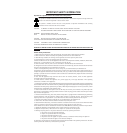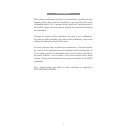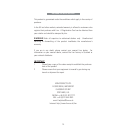
3
1
IMPORTANT SAFETY INFORMATION
Explanation of symbols used in this manual and on the product :
This symbol is intended to alert the user to the presence of uninsulated dangerous voltages within the
enclosure of sufficient magnitude to cause electric shock.
This symbol is intended to alert the user to the presence of important maintenance and servicing
information in the instruction and service manuals.
CAUTION: TO REDUCE THE RISK OF ELECTRIC SHOCK DO NOT REMOVE THE COVER.
NO USER SERVICEABLE PARTS INSIDE. REFER SERVICING TO QUALIFIED SERVICE PERSONNEL.
WARNING: SHOCK HAZARD. DO NOT OPEN.
AVIS: RISQUE DE CHOC ELECTRIQUE. NE PAS OUVRIR.
CAUTION: REPLACE FUSE WITH SAME TYPE AND RATING.
ATTENTION: UTILISER UN FUSIBLE DE RECHANGE DE MEME TYPE.
CAUTION: DISCONNECT SUPPLY CORD BEFORE CHANGING FUSE.
ATTENTION: DEBRANCHER AVANT DE REMPLACER LE FUSIBLE.
WARNING: TO REDUCE THE RISK OF FIRE OR ELECTRIC SHOCK DO NOT EXPOSE THIS APPLIANCE TO RAIN OR
MOISTURE.
General Safety Instructions :
1. Read Instructions. Read the safety and operating instructions before operating the appliance.
2. Retain Instructions. Retain the safety and operating instructions for future reference.
3. Heed Warnings. Observe all warnings on the appliance and in the operating instructions.
4. Follow Instructions. Follow all operating and use instructions.
5. Water and Moisture. Do not use the appliance near water, for example near a bathtub, washbowl, kitchen sink,
laundry tub, in a wet basement or near a swimming pool and the like.
6. Carts and Stands. Use only with a cart or stand that is recommended by the manufacturer.
6a. An appliance and cart combination should be used with care. Quick stops, excessive force and uneven surfaces
may cause the appliance and cart combination to overturn.
7. Wall or Ceiling Mounting. Mount to a wall or ceiling only as recommended by the manufacturer.
8. Ventilation. Site the appliance so that its location or position does not interfere with its proper ventilation. For
example the appliance should not be situated on a bed, sofa, rug or similar surface that may block the ventilation
openings; or placed in a built-in installation such as a bookcase or cabinet that may impede the flow of air through
the ventilation openings.
9. Heat. Site the appliance away from heat sources such as radiators, heaters, stoves or other appliances
(including amplifiers) that produce heat.
10. Power Sources. Connect the appliance to a power supply only of the type described in the operating
instructions or marked on the appliance.
11. Grounding or Polarisation. Do not defeat the safety purpose of the polarised or grounding type plug. A polarised plug
has two blades with one wider than the other. A grounding type plug has two blades and a third grounding prong. The
wide blade or the third prong is provided for your safety. When the provided plug does not fit into your outlet, consult
an electrician for replacement of the obsolete outlet.
12. Power Cord Protection. Route power cords so that they are not likely to be walked on or pinched by items
placed upon or against them, paying particular attention to cords at plugs, power sockets and at the point where
they exit from the appliance.
13. Protective Attachment Plug. As a safety feature the product is equipped with an attachment plug containing
overload protection. See the instruction manual about resetting or replacing the plug. Should the plug need
replacing ensure that a replacement is used which has the same overload protection as the original.
14. Cleaning The product should be cleaned only as recommended by the manufacturer.
15. Power lines. An outdoor antenna should be located away from power lines.
16. Outdoor Antenna Grounding. If an outdoor antenna is connected to the tuner/receiver ensure that the antenna
system is grounded to provide some protection against voltage surges and static build up.
In the USA see article 810 of the National Electrical Code ANSI/NFPA 70 concerning installation requirements.
17. Unplug this apparatus during lightning storms or when unused for long periods of time.
18. Objects and liquid entry. Take care not to let objects or liquids fall into the product.
19. Damage requiring Service. The product should be serviced by qualified personnel if :
a. the power cord or plug has been damaged.
b. objects or liquid have fallen into the product.
c. the product has been exposed to rain.
d. the product does not appear to operate normally or exhibits a marked change in operation.
e. the product has been dropped or the enclosure damaged.
20. Servicing. Don’t attempt to service the product beyond that described in the operating instructions. All other
servicing should be referred to qualified service personnel.
7
6


















